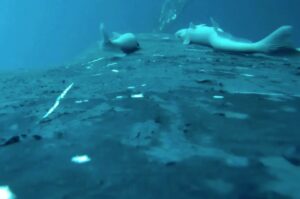In 2017, a churning tide cracked open 57-million-year-old boulders lying on a New Zealand beach.
Inside, scientists found the fossilized remains of two giant penguin species — one of which grew as tall as modern humans, weighed more than an NFL linebacker, and stalked ancient oceans looking for prey.
While it sounds like the start of a penguin-themed monster film (take note, Hollywood), that’s the real story described in The Journey of Paleontology on Wednesday.
Researchers named the larger bird Kumimanu, which translates from Maori as “monster bird,” and is now the largest penguin known to science. The second penguin, while smaller, still grew bigger and heavier than the Emperor penguin, the heavyweight champion among living species. It’s named Petradyptes, or rock diver.

Daniel Ksepka, a paleontologist and lead author of the new research, standing next to an upcoming penguin exhibit at Connecticut’s Bruce Museum. Photo: Bruce Museum
While scientists have known about Kumimanu since the 2017 discovery, the paper provides fascinating new details, including the bird’s likely weight: a staggering 160 kilograms — about the same as a full-grown gorilla.
Fragmented fossil remains make it difficult to know the bird’s height, but it likely rose to at least 1.6 meters, said Daniel Ksepka, a paleontologist at the Bruce Museum in Greenwich, Conn., and an author of the new study.
“If you’re a little one-pound penguin, a gull can just rip your head off,” Dr. Ksepka told The New York Times. “But a 300-pound penguin is not going to worry about a seagull landing near it because it would just crush it.”
New Zealand: Land of monster birds
While Kumimanu certainly sounds impressive, it’s also merely the latest example of a rogue’s gallery of giant-sized birds from New Zealand.
After the mass extinction of the dinosaurs, an absence of most large predators on both land on sea allowed flightless birds to flourish. Paleontologists have now documented many enormous bird species from the islands.
Those include nearly a dozen species of the now-famous moa, similar to modern-day emus. The tallest and heaviest bird known to science, moas could grow to 4.2 meters tall and weigh up to 270kg. They were hunted to extinction in the 15th century.
New Zealand’s ancient forests were also home to the largest eagle ever found. With its three-meter wingspan and tiger-sized claws, the Pouakai was capable of taking down even adult moas.
These other monster birds likely shared the islands with Kumimanu during the evolutionary transition following the fall of the dinosaurs. As for penguins, they’ve come a long way since Kumimanu, which had primitive flippers compared to their modern descendants.
Still, scientists don’t expect to find a penguin much larger than Kumimanu. Any larger, paleontologists say, and their bulk would likely crush their eggs into an unintended omelet.
So perhaps they were gentle giants, though it’s difficult not to imagine a face-to-face meeting with Kumimanu going something like this.






